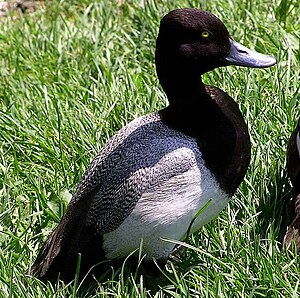Violet duck
| Violet duck | ||||||||||||
|---|---|---|---|---|---|---|---|---|---|---|---|---|

Violet Duck ( Aythya affinis ) |
||||||||||||
| Systematics | ||||||||||||
|
||||||||||||
| Scientific name | ||||||||||||
| Aythya affinis | ||||||||||||
| ( Eyton , 1838) |
The violet duck ( Aythya affinis ), also known as the little mountain duck , is a small diving duck from the duck family . It is a close relative of the circumpolar mountain duck and the old-world tufted duck . The plumage of the violet duck is very similar to these two species of duck, so that it is not always easy to distinguish the species from one another with certainty.
In Europe, the violet duck is a very rare wanderer, which is observed again and again, especially in Great Britain and Ireland. There are also observations from France, the Netherlands and Sweden, although the number of observations has recently increased. This increase in observations may be due to refugee prisoners .
features
Violet ducks are 38 to 48 cm long, weigh 700 to 1200 g and have a wingspan of about 75 cm. The male has a dark head that shines purple. The breast and tail are black, the elytra are lighter in pattern, and the belly is white. The beak is bluish, the eyes are yellow. The “pointed” head at the back is typical. Violet ducks are similar to Scallops . In both species the males have a black head, neck, chest and body end. Violet ducks are smaller and darker on the back. The males also have slightly different head shapes. The violet duck has an implied crest, so that the crown appears elongated. In contrast, the back of the head of the scallop is conspicuously sloping.
The female is gray-brown in color. The beak is outlined in white. The female of the violet duck can hardly be distinguished from that of the mountain duck. The clearest distinction can be made with flying ducks. While the white wing band extends to the wings of the scallop, in the violet duck the band on the outside of the wings turns gray-brown. The violet duck therefore looks as if it has a white mirror.
distribution
The violet duck breeds in Canada and Alaska as well as in the states of Oregon , Idaho , in northern Montana and in eastern South Dakota . The breeding pair density is greatest in the Canadian prairie regions. Main areas of distribution are Manitoba and Alberta . Her habitat are lakes, where she builds her nest in the reeds. As a migratory bird, it migrates further south to the USA , Central America and northern South America in winter .
The migratory movements to the wintering quarters are very complex. Many breeding birds of the prairie regions migrate to the southeast and even cross the Great Lakes to get to the Atlantic coast. Even some of the western populations cross the North American continent to spend the winter months here. However, large parts of the populations cross the interior to winter in the Gulf of Mexico .
Violet ducks occasionally get lost on their trains to Europe. So far there have been 16 documented sightings in the western Palearctic . Violet ducks have already been observed in Greenland , Great Britain , the Canary Islands and the Netherlands .
behavior
Food is aquatic plants and small animals. The breeding season is 21 to 28 days, the young fledged after 45 to 50 days.
Violet duck and people
Violet ducks are a popular game in the United States and Canada. Hunting for this species of duck has been restricted by law since 1988. A fundamental problem with hunting is that it is very difficult to estimate the population and the development of the population. The violet duck is too similar to the mountain duck to be able to determine reliable figures here. The violet duck could benefit from the introduction of mussels to the great lakes and rivers being warmed by industrial effluents. It would provide this species of duck with more food on their trains and they could possibly hibernate further north. To what extent these assumptions are true, however, has yet to be scientifically investigated. It is entirely possible that these potential positive effects will be neutralized by the disappearance of other types of mussels, which are an essential diet for this duck.
supporting documents
Individual evidence
- ↑ Hans-Günther Bauer, Einhard Bezzel and Wolfgang Fiedler (eds.): The compendium of birds in Central Europe: Everything about biology, endangerment and protection. Volume 1: Nonpasseriformes - non-sparrow birds , Aula-Verlag Wiebelsheim, Wiesbaden 2005, ISBN 3-89104-647-2 , p. 120
- ↑ Kear, p. 680
- ↑ Gooders and Boyer, p. 106
- ↑ Kear, p. 685
literature
- Janet Kear (Ed.): Ducks, Geese and Swans. Oxford University Press, 2005, ISBN 0-19-854645-9 .
- Hartmut Kolbe; Die Entenvögel der Welt , Ulmer Verlag 1999, ISBN 3-8001-7442-1
- John Gooders and Trevor Boyer: Ducks of Britain and the Northern Hemisphere , Dragon's World Ltd, Surrey 1986, ISBN 1-85028-022-3
Web links
- Aythya affinis in the endangered Red List species the IUCN 2008. Posted by: BirdLife International, 2004. Retrieved on January 3 of 2009.
- Videos, photos and sound recordings on Aythya affinis in the Internet Bird Collection
